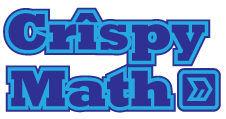Trig Puzzle
/Generally reinventing the wheel is not the way to go with a math activity but I am a glutton for punishment sometimes. Years ago teaching pre-algebra I had made students a handwritten puzzle worksheet in which to solve they had to cut out the pieces and reassemble them into a box making sure to align the sides using exponent rules. This, I think, might have been inspired by a similar Pizzazz worksheet.
These ladies were on fire during this activity. Just outside my classroom are these awesome booths where students can work, love em.
Anyhow, in one of my recent field trips through Sam's filing cabinet I remembered downloading something similar called a Tarsia puzzle. I would create one for my trigonometry students I figured. They had mastered the Unit Circle and I wanted to have them use the unit circle to have them think about some of the basic identities (odd, even, co-function etc.) I figured one of these puzzle worksheets could serve this purpose well. It might also be a nice bridge between the trig we had done so far and the next lesson I had originally planned about identities that I feared would be too hard. It turns out there is a free program to create these Tarsia puzzles (great resource here), but alas it is Windows only and at home I only have a Mac. Nevertheless the idea was gnawing at me so I decided to go for it and make my own.
I found the PDF I had downloaded from Sam's site (I can't seem to find the exact link) and opened it in Illustrator. From here I was able to delete all the original equations and add new ones I created in Math Type. Before I entered any equations into Illustrator I made a list of the six identities I wanted to focus on and made eighteen pairs that students would have to match. Next I drew the final shape for my puzzles' picture on paper and entered the equations to create the key. From here it was relatively easy to create the student version of the worksheet because I just cut up my key and entered my triangles into Illustrator. It was initially challenging to get the text rotated and oriented properly but by the time I had entered a few triangles of data I was a pro. Additionally, I decided to add a couple layers to what was already a puzzle. First, I did not tell my students what final shape the triangles would be assembled into, and second I added a quote (that connects to the shape) that would reveal itself when the puzzle was completed. Further the quote has blanks that need to be filled in, making it even more challenging. I also figured that the blanks in the quote would make it more difficult for students to work the puzzle backwards. The quote also made it really easy to check to see if the puzzle was properly solved.
I've used this activity with two of my three algebra two classes so far and it has gone great. It is a little bit more difficult than I intended but in one class one group was able to crack the whole thing during the time allotted but just barely. Another group stayed behind after class to finish it. During the lesson I moved from group to group and helped students make connections between the puzzle and the unit circle, great lesson for a Friday afternoon math class.



